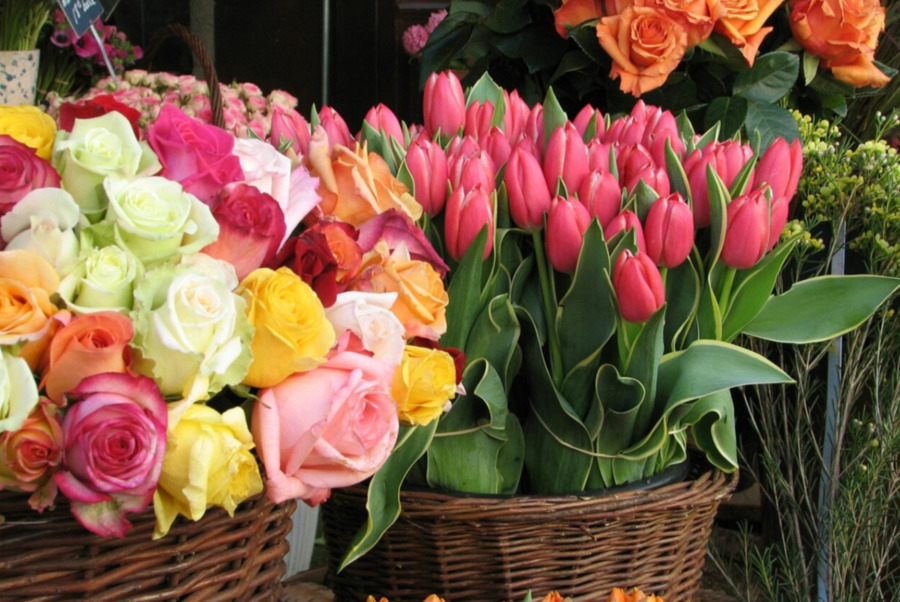Flowers have long captivated the human imagination with their delicate beauty and profound symbolism. Among the myriad blooms that grace our lives, roses, and tulips are iconic, each holding a special place in gardens, cultures, and hearts worldwide. These flowers are beloved for their aesthetic appeal and cherished for their ability to convey deep emotions and add splendor to any occasion.
Roses, with their intricate layers and enchanting fragrances, have become symbols of love, passion, and devotion. But their appeal goes beyond these emotions. They are stapled in romantic gestures, anniversaries, Valentine’s Day celebrations, and solemn occasions like memorials. Their universal allure and extensive variety make them versatile for many settings and purposes, from expressing love to adding elegance to a space. Whether you’re looking to buy flowers for a special occasion or just to beautify your home, roses offer timeless beauty and many options.
On the other hand, Tulips are not just flowers; they are a part of history and culture. Celebrated for their bold colors and elegant shapes, they embody cheerfulness and perfect love. Originating from the wilds of Central Asia and famously central to a historical economic bubble in the Netherlands, tulips bring a touch of spring’s promise to any environment. They are particularly favored in festive events and as a herald of spring in floral arrangements, making them a fascinating subject for those interested in history and culture. Buying tulips can enhance any setting, providing a splash of color and a hint of history to your floral displays.
This blog post will explore the fascinating world of roses and tulips, exploring their unique characteristics, care requirements, symbolic meanings, and best uses. Whether you decide on a flower for a specific event or wish to learn more about these popular choices, understanding their distinctions and similarities will enhance your appreciation and help you make informed decisions for your floral needs.
Historical Background and Origin of Roses and Tulips
Roses have an ancient and storied history, spanning thousands of years and multiple cultures. Their cultivation began around 5,000 years ago, likely in China, where they were grown for ornamental and medicinal purposes. From there, their cultivation spread across the ancient world, including Egypt, where they were used in funerary rituals to decorate tombs and various ceremonies.
By the time of the Roman Empire, roses had become deeply embedded in social and public life. They were used extravagantly in banquets, as adornments for statues and buildings, and even strewn on the streets during festivals. Romans also cultivated large public rose gardens in the south of Rome, reflecting the flower’s importance in their society.
The symbolic significance of roses varies widely across cultures. In Christian iconography, the red rose became associated with the blood of Christ, while the white rose symbolized purity and was often linked to the Virgin Mary. In contrast, Islamic and Eastern traditions view the rose as a symbol of spiritual transcendence and heavenly paradise. Roses have also long been a symbol of love and passion, a theme that has persisted into modern times across the globe.
Tulips, unlike roses, have a more concentrated area of origin—Central Asia. Wild tulips were first cultivated in Persia around the 10th century, where they were appreciated for their beauty and as a symbol of paradise on earth. The flowers were later introduced to The Ottoman Empire, where they became highly prized at the Sultan’s court, and the era of the Tulip Era (1718-1730) is named for the flower’s importance in Turkish culture.
The introduction of tulips to Europe occurred in the 16th century, when Ferdinand I’s ambassador to the Sultan, Ogier Ghiselin de Busbecq, brought them from the Ottoman Empire to the Netherlands. The Dutch, renowned for their horticultural skills, quickly took to tulip cultivation, breeding them to create spectacular colors and forms. This fascination led to the infamous “Tulip Mania” in the early 17th century—a period during which the desire for tulip bulbs reached such heights that their prices soared dramatically, resulting in what is considered the first recorded speculative bubble. At its peak, some single tulip bulbs were being sold for prices that could buy a house in Amsterdam. The bubble eventually burst in 1637, but the tulip’s popularity endured, and it remains a symbol of the Netherlands and a key component of the horticultural industry there.
Both roses and tulips have rich histories reflecting their beauty and complex meanings for different societies. These flowers add color and fragrance to our environments and carry deep cultural and historical significance.
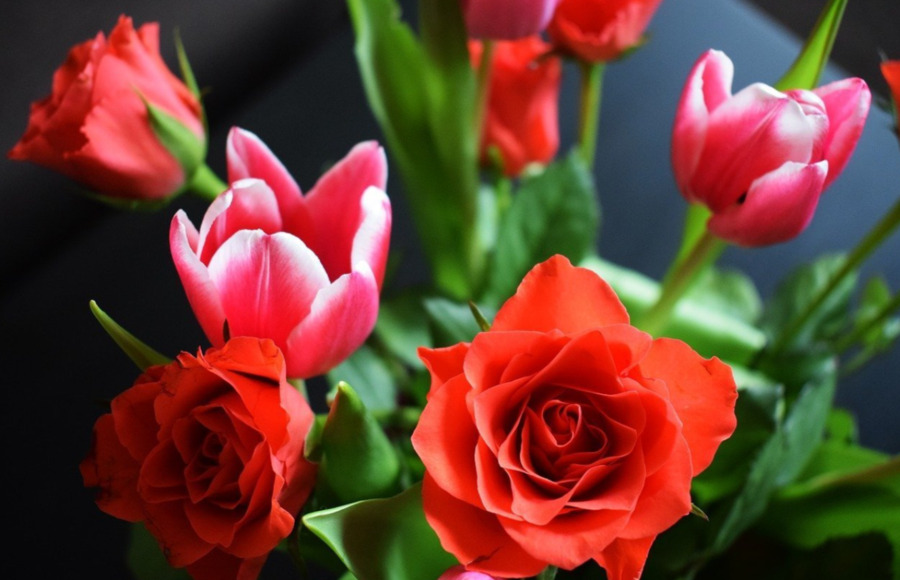
Physical Characteristics of Roses and Tulips
Roses are renowned for their extraordinary diversity and beauty, manifesting in many colors, sizes, and forms. This versatility makes them a favorite among gardeners and floral enthusiasts alike.
- Color: Roses come in a vast palette of colors. Traditional hues include red, white, and yellow, but the range extends to pink, orange, peach, and even more exotic bi-colors and deep purples. Each color often carries its symbolic meaning, making roses particularly meaningful in floral arrangements.
- Size: The size of rose blooms can vary significantly depending on the variety. Some miniature roses may have tiny blooms only a few centimeters in diameter, while grandiflora or hybrid tea roses can feature large flowers up to 5 inches across. The bush size also varies, from compact varieties suitable for borders to larger shrubs that can dominate a garden space.
- Form: Rose flowers can exhibit a variety of forms, from the tightly packed petals of a classic hybrid tea rose to the more open, casual form of wild or heritage roses. Some roses are famous for their classic high-centered buds, while others are cherished for their cupped or rosette shapes.
- Stem Characteristics: Roses can also be categorized by their stem characteristics. Single-stem roses, often seen in hybrid teas, bear one large bloom per stem and are popular in bouquets. In contrast, floribunda and spray roses produce multiple smaller blooms per stem, creating a more desirable appearance in garden settings and informal floral arrangements.
- Fragrance: Roses’ fragrance is an additional characteristic that adds to their allure. Depending on the variety, it can range from subtle to intensely aromatic. Some roses are specifically bred for their scent, which can evoke everything from classic roses to fruity, spicy, or even musky undertones.
Tulips are celebrated equally for their vibrant colors and elegant form, which make them synonymous with spring and renewal.
- Shape: The most iconic feature of tulips is their cup-shaped blooms, which can be star-shaped or rounded. The petals are generally smooth and can form an almost perfect cup, especially when the flowers are fully open in full sun.
- Color: Tulips display a broad spectrum of colors. They can be found in nearly every shade, from the deepest purples and reds to pastel pinks, yellows, and whites. Some tulip varieties feature petals with multiple colors, displaying stripes, fringes, or flames resulting from viral infections, which have been historically admired and highly sought after.
- Size: Tulip flowers and plants vary from small, delicate species to modern cultivars’ larger, bold blooms. The flowers typically range from 2 to 6 inches, and the overall plant height varies from a diminutive 4 inches to over 2 feet for some larger varieties.
- Stem and Leaves: Tulips have a single stem per bulb that supports the flower. The stems are generally smooth and sturdy, helping the flower’s weight. The leaves are long and lance-shaped, usually green, and arranged in a basal rosette around the base of the stem.
- Blooming Period: Unlike roses, which can often rebloom throughout the growing season, tulips have a specific flowering period in the spring. Once a tulip flower fades, the plant typically only blooms again in the following year, as the bulbs require a period of dormancy
Both roses and tulips offer unique attributes that cater to different gardening and decorative needs, making each an excellent choice depending on the setting and intent of their use. Their physical characteristics contribute to their beauty and functionality in various landscapes and floral designs.
Symbolic Meanings of Roses and Tulips
Roses and tulips, rich symbolism, and versatile colors empower you to express various sentiments. Each hue carries a distinct message, allowing you to tailor your choice to the occasion and the emotions you wish to convey.
- Red Roses: Universally recognized as the symbol of deep love and affection, red roses are traditionally associated with romantic love. They are a staple for occasions like Valentine’s Day and anniversaries, often used to convey heartfelt emotion and passion.
- White Roses: Symbolizing purity, innocence, and new beginnings, white roses are often chosen for weddings, christenings, and other ceremonies that mark fresh starts. They also convey respect and remembrance, making them suitable for funerals or memorial services.
- Yellow Roses: Once symbolizing jealousy, modern interpretations of yellow roses have shifted to represent friendship, joy, and good health. They are commonly given to celebrate friendships, cheer up loved ones, or as a gesture of goodwill.
- Pink Roses: Varying shades of pink can express different degrees of affection and admiration. Light pink roses often denote grace, sweetness, and joy, while darker shades can signify gratitude and appreciation. They are frequently used in expressions of thanks and congratulations.
- Orange Roses: These vibrant flowers symbolize enthusiasm and desire. They are a bold choice, used to express fascination and passionate emotions, making them a less traditional but impactful option for romantic interests.
- Blue Roses: Traditionally, blue roses do not exist naturally and thus represent the unattainable or the mysterious. They often symbolize mystery, the pursuit of the impossible, or an extraordinary venture.
- Lavender Roses: An expression of enchantment and love at first sight, they can also convey a sense of regal majesty and splendor, making them a unique choice for romantic gestures.
Like roses, tulips carry a wealth of meaning, though they are most commonly associated with perfect love. Each color of the tulip has significance, adding layers of meaning to this beloved flower.
- Red Tulips: Strongly associated with true love, red tulips declare deep love and are often less tied to the commercialism of romantic gestures, offering a more down-to-earth approach than red roses.
- Yellow Tulips: Once representing hopeless love, modern interpretations suggest that yellow tulips symbolize cheerfulness and hope. They are excellent for lifting spirits and conveying a sunny disposition.
- White Tulips: Symbolizing forgiveness, purity, and honor, white tulips are another excellent choice for weddings to convey a message of forgiveness or to claim a clean slate.
- Purple Tulips: Associated with royalty and elegance, purple tulips convey a sense of dignity and pride, making them suitable for occasions deserving of respect and admiration.
- Pink Tulips: Pink tulips represent happiness and confidence in various contexts, from showing affection to expressing contentment with life.
- Orange Tulips: Symbolizing energy, enthusiasm, and warmth, orange tulips are perfect for any occasion celebrating joy, happiness, or a new venture.
With their complex language of colors, roses, and tulips can significantly enhance the emotional resonance of a gift or decoration. Whether used alone or mixed in bouquets, the choice of color and type of flower can deeply touch the recipient’s heart, making your gesture more meaningful.
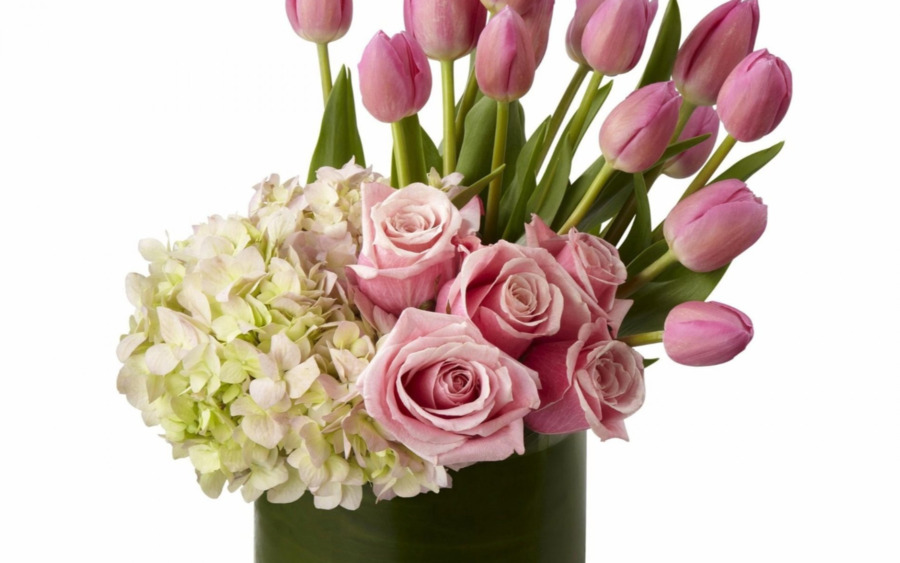
Seasonal Availability and Growing Conditions of Roses and Tulips
Roses are remarkably versatile and widely cultivated around the globe, which allows them to be available year-round. The varied climates across different regions facilitate this extensive cultivation, each contributing to a continuous supply:
- Global Cultivation: Roses are grown on every continent except Antarctica, which means they can be harvested throughout the year. Major rose-producing countries include the Netherlands, Colombia, Ecuador, Kenya, and the United States, each with specific seasons for optimal growth.
- Controlled Environments: In colder or more variable climates, roses are often grown in greenhouses where light, temperature, and humidity can be controlled. This technology allows for the year-round production of high-quality roses, independent of external weather conditions.
- Growing Requirements: Roses generally require well-drained, fertile soil and adequate sunlight. They are hardy but do best with regular watering, feeding, and pruning to encourage continuous blooming throughout their growing season.
Unlike roses, tulips are highly seasonal and have specific growing requirements that limit their flowering period to spring. Here’s what influences their growth and availability:
- Colder Winter Requirement: Tulips require winter chill to bloom. The bulbs are planted in the fall, undergo a dormant period in the winter, and bloom in the spring. This chilling period is crucial for developing the flower bud within the bulb.
- Spring Blooming: Once the temperature rises in spring, tulip bulbs break dormancy, leading to rapid plant growth and flowering. This typically occurs from March to May in the Northern Hemisphere. The exact timing of tulip blooms can vary depending on the specific variety and local climate conditions.
- Growing Zones: Tulips are best suited to climates with a cold winter and a dry summer, which mimic their native Central Asian habitat. They are perennial in hardiness zones 3 through 8, where they can be left in the ground to regrow each year. In warmer climates, tulip bulbs must be chilled in a refrigerator before planting to simulate winter conditions.
- Post-Blooming Care: After tulips bloom, their foliage should be allowed to die back naturally; this process helps the bulb gather nutrients for the next year’s growth. However, tulips are treated as annuals in many warmer regions because they do not naturally undergo the required dormancy period.
The distinct differences in seasonal availability and growing conditions between roses and tulips highlight their unique botanical and care needs. Roses offer year-round continuity, while tulips bring a celebrated but fleeting herald of spring. Each adds its special charm and beauty to gardens and floral arrangements.
Care and Handling of Roses and Tulips
Proper care and handling of roses can significantly extend their vase life and enhance their beauty. Here are some detailed steps to ensure your roses stay fresh longer:
- Preparation:
- Cutting Stems: Upon receiving roses, cut the stems diagonally about one inch from the bottom, ideally under water. This prevents air from entering the veins in the stem, allowing for better water absorption.
- Water Temperature: Use lukewarm water, as it’s more readily absorbed by the stems than cold water, which can shock the flowers.
- Water and Container:
- Clean Vase: Always use a clean vase to prevent bacterial growth, which can clog the stems and shorten the life of the flowers.
- Fresh Water: Change the water completely every two days to keep it fresh and clear of bacteria. When changing the water, re-cut the stems to ensure they remain open and able to absorb water.
- Environmental Factors:
- Location: Keep roses away from direct sunlight, drafts, and heat sources, as these can dehydrate the flowers quickly.
- Humidity: In very dry climates, it can be helpful to mist the petals and leaves to maintain a higher humidity around the flowers, mimicking their natural environment.
- Leaf Maintenance:
- Remove Lower Leaves: Remove any leaves that fall below the water line to prevent rot and bacterial growth in the water.
- Feed Your Roses:
- Flower Food: Use commercial flower food in the water, which provides sugars for energy and antibacterial agents to keep the water clean. Make sure to follow the packet’s instructions for the correct dosage.
Tulips also have specific care requirements, particularly noting their interesting behavior of continuing to grow and bend towards light sources even after being cut:
- Preparation:
- Cut Stems: Cut tulip stems in water diagonally before placing them in water. This helps increase the amount of water absorbed.
- Pierce Stems: Some florists recommend piercing the stems just below the flower heads with a pin or small needle to interrupt the upward flow of water and nutrients to prevent them from curling excessively.
- Water and Container:
- Cool Water: Unlike roses, tulips fare better in cool water to help keep them crisp and firm.
- Water Level: Keep the water level low (about an inch or two) as tulips grow and can rot if too much of their stem is submerged.
- Environmental Factors:
- Avoid Heat and Light: Place tulips in a cool location away from direct sunlight and heat, which can cause them to droop prematurely. Tulips are particularly sensitive to heat and stretch towards light sources, often bending their stems dramatically.
- Rotation:
- Rotate the Vase: Regularly rotating the vase can help it grow even more and prevent excessive bending toward a single light source.
- Support:
- Provide Support: To keep stems straight, wrap the bouquet snugly in newspaper and stand it in water for a few hours. This encourages them to stay upright.
Following these detailed care tips for roses and tulips can significantly enhance their lifespan and visual appeal, ensuring they provide beauty and joy for as long as possible.
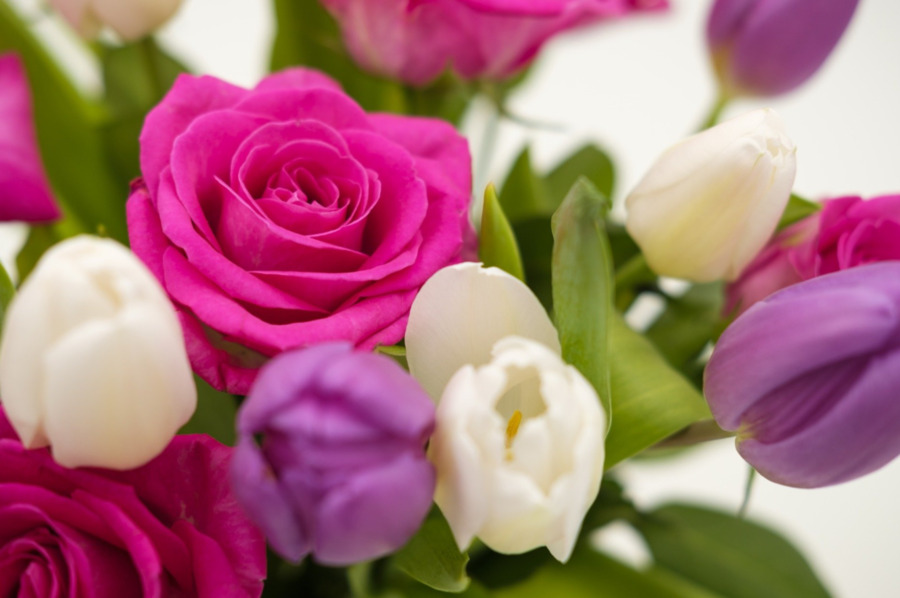
Pricing and Availability of Roses and Tulips in the UAE
The availability and pricing of flowers like roses and tulips in the UAE can vary significantly based on several factors, including seasonality, rarity, and import costs. Here’s a detailed look at these popular flowers’ pricing and availability dynamics within the UAE market:
Roses
General Availability:
- Roses are widely available year-round due to extensive global imports from countries like Kenya, the Netherlands, and Ecuador. Local florists, supermarkets, and online stores regularly stock a variety of roses, catering to the constant demand.
Pricing:
- Standard Varieties: The price of standard roses in the UAE generally remains stable throughout the year. A bouquet of a dozen standard roses can cost anywhere from AED 150 to AED 300, depending on the quality and specific florist pricing.
- Rare Varieties: Rare and premium varieties such as long-stemmed or unique-colored roses (like blue or black) can be considerably more expensive. Prices for these can range from AED 300 to over AED 500 for a dozen, reflecting their rarity and special care needs during cultivation and transport.
- Factors Influencing Price: Pricing can also fluctuate during peak demand times such as Valentine’s Day, Mother’s Day, and Christmas, where the cost of roses might spike due to increased demand and logistic charges.
Tulips
Seasonal Availability:
- Tulips are primarily available in spring (from March to May). During this season, tulips are imported mainly from the Netherlands, making them more affordable and widely available.
- Outside their peak season, tulips are less commonly found and are typically more expensive due to the additional costs associated with storing and transporting them off-season.
Pricing:
- Spring Season: During their peak season, the price for a bouquet of ten tulips can range from AED 100 to AED 200, depending on the color and size of the blooms.
- Off-Season: Prices in the off-season can increase significantly, with costs ranging from AED 200 to AED 350 for a similar bouquet due to the decreased supply and increased logistical efforts to maintain freshness.
- Special Varieties: Like roses, special varieties of tulips (such as fringed or parrot tulips) are priced higher due to their unique appearance and lower availability.
Factors Influencing Price and Availability in the UAE:
- Import Costs: Both roses and tulips are largely imported into the UAE, and thus, their prices are subject to fluctuations in international market rates, changes in supply chains, and variations in currency exchange rates.
- Logistical Considerations: The costs associated with maintaining the cold chain during transport, especially for tulips, which are more sensitive to temperature changes, also contribute to their final retail price.
- Local Demand: The diverse population in the UAE celebrates various occasions year-round, influencing the consistent demand for flowers like roses and tulips and affecting their availability and pricing.
Understanding these dynamics helps consumers in the UAE anticipate price changes and availability, allowing them to plan purchases for events and gifts accordingly.
Allergenic Potential of Roses and Tulips
Whether picking flowers for your enjoyment or as a thoughtful gift, it’s crucial to grasp the allergenic potential of different species. This knowledge is vital in environments like hospitals or homes, where individuals may be more vulnerable to allergens. Let’s delve into the allergenic properties of roses and tulips to equip you with the necessary information:
Roses
Low Allergen Profile:
- Roses are generally recognized for their low allergenic potential. This is primarily because most rose varieties do not produce a significant amount of airborne pollen is the common cause of allergic reactions to flowers.
- The structure of a rose’s pollen grains makes it less likely to become airborne; they are heavier and tend to fall straight to the ground. This characteristic minimizes the chances of the pollen entering the respiratory system, which is a typical pathway for allergic reactions.
Suitability for Sensitive Settings:
- Due to their low allergenic potential, roses are an excellent choice for hospital gifts or people prone to allergies. Their minimal impact on indoor air quality makes them a safe and beautiful option for decorating enclosed spaces without posing a significant health risk to individuals with allergies.
Considerations:
- Although roses are generally safe, it’s important to note that some people might still be sensitive to the scent or the other parts of the flower, such as the sap, which can cause skin irritations in very sensitive individuals.
Tulips
Moderate Allergen Profile:
- Tulips, unlike roses, can pose a higher risk for allergens, primarily due to their pollen. Tulip pollen is lighter and can become airborne more easily than rose pollen, making it more likely to trigger allergic reactions in sensitive individuals.
- Additionally, tulips are part of the Liliaceae family, known for causing allergic reactions due to pollen and exposure to the bulb’s skin, which can cause dermatitis in individuals handling them without proper protection.
Caution for Allergy Sufferers:
- Avoiding tulips or handling them carefully is advisable for those with severe allergies, especially pollen allergies. This includes placing tulips in an area that does not promote the dissemination of pollen, such as away from direct airflow paths like air conditioners or fans.
Handling Precautions:
- Individuals who plant or handle tulip bulbs should wear gloves to avoid skin contact with the bulbs, which contain allergenic compounds that can cause dermatitis (tulip fingers). Washing hands thoroughly after handling tulips or bulbs is also recommended to prevent skin irritation.
General Tips for Allergy Sufferers
- Flower Selection: Opt for flowers with low allergenic potential, like roses, especially for indoor environments, or gifts for individuals with known sensitivities.
- Placement: Keep any flowers well-hydrated and in places with minimal airflow to reduce the chances of pollen spreading.
- Hygiene: Regularly cleaning surfaces and washing hands after handling flowers can help minimize allergic reactions.
By understanding the allergenic potential of roses and tulips, individuals can make more informed choices about which flowers to bring into their homes or give to others, ensuring both beauty and well-being are optimally maintained.
Ecological Impact of Rose and Tulip Cultivation
The cultivation of flowers, while adding beauty and vibrancy to environments, also carries significant ecological footprints, particularly concerning the use of resources like water and land, as well as the application of chemicals such as pesticides and fertilizers. Here’s a detailed look at the ecological impacts of growing roses and tulips:
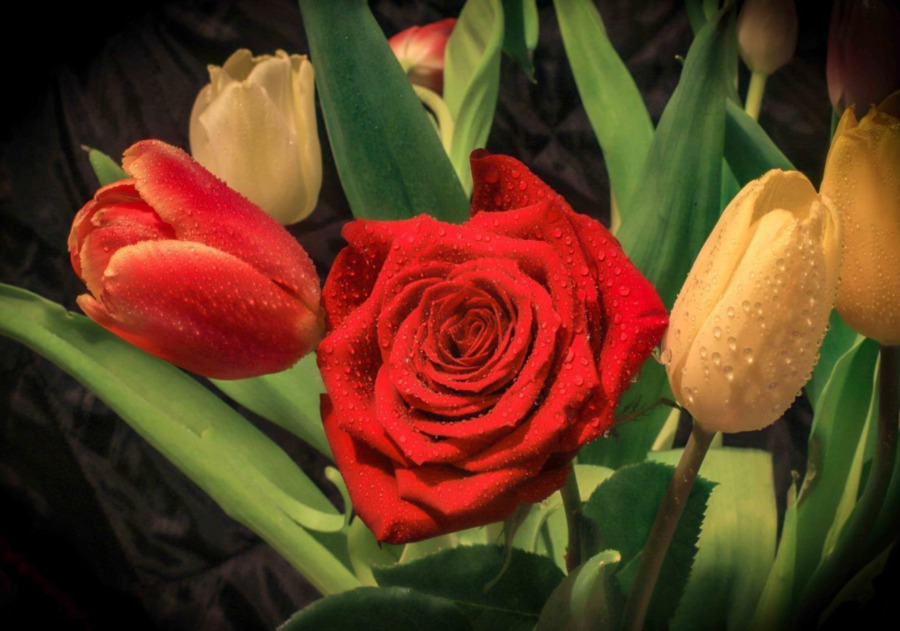
Roses
Pesticide Use:
- Rose cultivation often requires intensive pesticide use to maintain high-quality blooms free from pests and diseases. Roses are particularly susceptible to a range of fungal diseases and insect pests, necessitating frequent applications of chemical treatments.
- The heavy use of pesticides can lead to several environmental issues, including contamination of local water sources, harm to non-target species (such as beneficial insects or nearby plants), and disruption of local ecosystems. Pesticide residues on flowers are also a concern, which can have health implications for consumers and handlers.
Water Consumption:
- Roses are water-intensive plants, requiring significant amounts of water throughout their growing season to maintain health and ensure quality flower production. In regions where water scarcity is a pressing issue, such as many parts of the world where roses are grown commercially (including parts of Africa, South America, and even the Middle East), the large-scale irrigation needed for rose cultivation can strain local water resources.
- This intensive water use can compete with other needs, such as drinking water and irrigation for food crops. It can lead to the depletion of local aquifers and reduced water availability for other agricultural and personal uses.
Carbon Footprint:
- The global trade in roses contributes to a high carbon footprint due to the need to transport flowers by air to maintain their freshness. Air transport is one of the most carbon-intensive modes of transportation, significantly contributing to greenhouse gas emissions.
Tulips
Land Use:
- Tulip cultivation requires extensive land use, particularly in prime agricultural regions like the Netherlands. The demand for tulip bulbs and flowers can lead to large areas devoted exclusively to tulip growing.
- This specialization can reduce biodiversity in these regions, as fields are often cleared of other vegetation to make way for tulips. Moreover, the monoculture practice in tulip farming can deplete soil nutrients and reduce overall soil health, making land less available or suitable for other types of agriculture.
Chemical Use:
- Like roses, tulips also require pesticides and fungicides to prevent disease and pest infestation. These chemicals can affect local wildlife and water sources, contributing to ecological degradation.
- Tulip bulbs, treated with fungicides and sometimes growth regulators, can have environmental impacts if these chemicals leach into the soil or water systems.
Crop Rotation and Soil Health:
- Tulip production often involves crop rotation to maintain soil health and prevent disease build-up. While this practice can be beneficial, the continuous need for new land to rotate crops can lead to further agricultural expansion, potentially encroaching on natural habitats.
Addressing Environmental Impacts
Both rose and tulip cultivation face challenges in minimizing environmental impacts. Sustainable practices such as integrated pest management, organic farming, using renewable energy sources for greenhouse operations, and implementing efficient water use strategies are crucial. Moreover, as consumer awareness increases, a growing demand for sustainably grown flowers could help shift industry practices towards more environmentally friendly techniques.
Conclusion: Choosing Between Roses and Tulips
In exploring roses and tulips, we’ve delved into their rich histories, unique physical characteristics, deep symbolic meanings, seasonal availability, and care requirements. We’ve also examined the ecological impacts of their cultivation, highlighting the importance of considering environmental sustainability when choosing flowers.
When selecting between roses and tulips, consider the message you wish to convey and the occasion. With their year-round availability and wide variety, roses can suit almost any event, emotion, or setting. They are particularly apt for expressing deep and enduring sentiments. With their cheerful and less formal appearance, Tulips are ideal for springtime gifts and decorations, perfect for new beginnings and casual yet heartfelt expressions of affection.
For those environmentally conscious, researching the source of the flowers, the farming practices used, and opting for locally grown varieties can reduce your ecological footprint. Many florists now offer sustainable options that prioritize the health of the planet. As you choose between these two beautiful flowers, consider their aesthetic appeal, the joy they will bring, and the deeper meanings each flower holds. Whether you mark a special occasion, express an emotion, or add beauty to your space, let your choice reflect your values and the unique message you wish to convey.
Remember, the decision between roses and tulips is not just a choice between two types of flowers—it’s an opportunity to connect with nature, participate in ancient traditions of floral symbolism, and make a conscious decision that aligns with your environmental values. Enjoy the process of selecting the perfect blooms to enhance your life and the lives of those you care for.

Fixie owner, vegan, record lover, vintage furniture lover and typography affectionado. Acting at the sweet spot between simplicity and intellectual purity to create great work for living breathing human beings. My opinions belong to nobody but myself.
